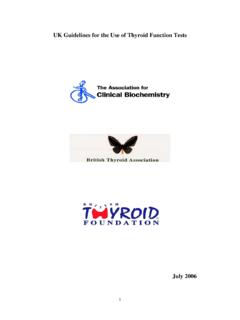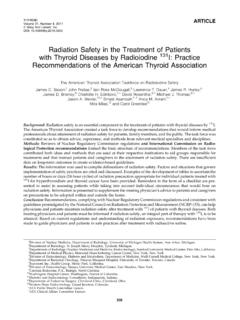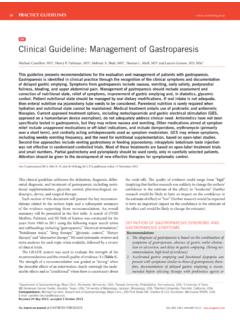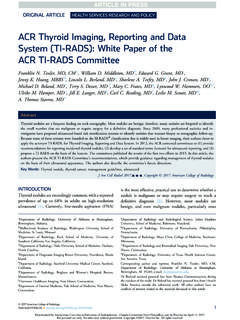Transcription of UK Guidelines for the Use of Thyroid Function Tests
1 1 UK Guidelines for the Use of Thyroid Function Tests July 2006 2 Contents Guidelines development group 4 Notes on the development and use of the Guidelines 5 Types of evidence and the grading of recommendations 7 Abbreviations 8 Presentation conventions 9 Acknowledgements 10 1. Introduction Thyroid disease 11 Thyroid Function Tests 11 The patient perspective 11 The physician perspective 12 The laboratory perspective 12 The need for national Guidelines 12 2.
2 Indications for Thyroid Function testing Introduction 15 Screening for Thyroid dysfunction 15 Surveillance of Thyroid Function 20 Monitoring of Thyroid Function 22 3. Hypothyroidism Primary hypothyroidism 24 Subclinical (mild) hypothyroidism 27 Secondary hypothyroidism 28 Congenital hypothyroidism 30 4. Hyperthyroidism Primary hyperthyroidism 32 Subclinical (mild) hyperthyroidism 36 Inappropriate TSH 37 5. Thyroid Function in pregnancy Introduction 39 Hypothyroidism 39 Hyperthyroidism 40 Post-partum thyroiditis 42 Screening for Thyroid disease during pregnancy 42 Neonatal Thyroid assessment 43 6.
3 Thyroid Function testing in Thyroid cancer Introduction 46 Differentiated Thyroid cancer 46 Medullary Thyroid cancer 49 Anaplastic Thyroid cancer 51 3 Contents (continued) 7. Laboratory aspects of Thyroid Function testing Introduction 52 Biochemical investigations for Thyroid Function 52 Tests to establish if there is Thyroid dysfunction 52 Selective use of Thyroid Function Tests 54 Reference ranges 55 Quality control and quality assurance 56 Interpreting results of Thyroid Function Tests 57 Follow-up of unusual test results 61 Laboratory Tests used to determine the cause of Thyroid dysfunction 61 Recommended protocol for determining functional sensitivity 66 Drugs that alter Thyroid hormone synthesis, secretion & metabolism 66 8.
4 Areas for further studies 68 Appendix 1 References 69 4 Use of Thyroid Function Tests : Guidelines development group Working party membership Professional body represented Graham H Beastall BSc, PhD, FRCPath Secretary, guideline development group Consultant Clinical Scientist, Glasgow Geoffrey J Beckett BSc, PhD, FRCPath Association for Clinical Biochemistry Reader in Clinical Biochemistry, Edinburgh Jayne Franklyn MD, PhD, FRCP, FMedSci British Thyroid Association Professor of Medicine, Birmingham William D Fraser MD, MRCP, FRCPath Association for Clinical Biochemistry Professor of Clinical Biochemistry, Liverpool Janis Hickey British Thyroid Foundation Patient representative. Founder and Director of BTF Rhys John BSc, PhD, FRCPath Association for Clinical Biochemistry Consultant Clinical Scientist, Cardiff Pat Kendall-Taylor MD DCH FRCP British Thyroid Association Emeritus Professor of Endocrinology, Newcastle Upon Tyne Betty Nevens British Thyroid Foundation Patirnt representative.
5 Office Manager for BTF Mark Vanderpump MD, FRCP British Thyroid Association Consultant Physician, Royal Free Hospital, London 5 Notes on the development and use of the Guidelines The Guidelines development group The Use of Thyroid Function Tests Guidelines Development Group was formed in 2002 under the auspices of the Association for Clinical Biochemistry (ACB), the British Thyroid Association (BTA) and the British Thyroid Foundation (BTF). Purpose of the Guidelines It is hoped that the document will provide guidance for primary care physicians, specialist physicians, endocrinologists, and clinical biochemists. The accompanying patient information sets have been especially designed to explain Thyroid Function testing and to summarise the main recommendations in the Guidelines in everyday language. The purpose of the Guidelines is to encourage a greater understanding of Thyroid Function testing amongst all stakeholders with a view to the widespread adoption of harmonised good practice in the diagnosis and management of patients with Thyroid disorders.
6 The Guidelines are also intended to provide a basis for local and national audit and each section offers recommendations that are suitable for the audit process. The document should be considered as Guidelines only; it is not intended to serve as a standard of medical care. The doctors concerned must make the management plan for an individual patient. The focus of the document is Thyroid Function testing, and it is not intended to be a comprehensive text on Thyroid disorders. The process of development The guideline development group met on several occasions. It was agreed to adopt the literature review accompanying the 2002 publication of The National Academy of Clinical Biochemistry entitled Laboratory support for the Diagnosis and Monitoring of Thyroid Disease and to supplement this with publications occurring during and after 2001. Subgroups took responsibility for individual chapters and the whole group considered each draft.
7 Patient representatives were full members of the development group throughout the development process. After completion by the development group, the Guidelines were subjected to external refereeing by individuals with a range of interests, including patients, GP s, physicians and laboratory specialists in district general hospitals and teaching centres as well as international experts. In addition the draft Guidelines were posted on the websites of the ACB and BTA, with appropriate links, for a limited period, during which comments were invited and received. Subsequent to this the development group reviewed the comments and recommendations and appropriate revisions were made. All members of the group approved the Guidelines . 6 Mechanism for updating The Guidelines were completed in June 2006. Comments on their accuracy and relevance are invited during the first year after publication and should be directed to It is intended that a full review will take place after three years.
8 Additional information The format and style of the Guidelines has been modelled on the complementary document entitled Guidelines for the Management of Thyroid Cancer in Adults , which was published in 2002 by The Royal College of Physicians. The British Thyroid Foundation funded the project. No declarations of interest were received from any of the professional members of the development group. These Guidelines and the accompanying patient information sets may be downloaded from the ACB and BTA websites: 7 Types of evidence and the grading of recommendations The definition of types of evidence and the grading of recommendations used in the Guidelines follows that of the Agency for Health Care Policy and Research (AHCPR), as set out below: Type of evidence (based on AHCPR, 1992) Level Type of evidence _____ Ia Evidence obtained from meta-analysis of randomised controlled trials.
9 Ib Evidence obtained from at least one randomised controlled trial. IIa Evidence obtained from at least one well-designed controlled study without randomisation. IIb Evidence obtained from at least one other type of well-designed quasi-experimental study. III Evidence obtained from well-designed non-experimental descriptive studies, such as comparative studies, correlation studies and case control studies. IV Evidence obtained from expert committee reports or opinions and/or clinical experience of respected authorities. Grading of recommendations (based on AHRQ, 1994) Grade Evidence levels Description _____ A Ia, Ib Requires at least one randomised controlled trial as part of the body of literature of overall good quality and consistency addressing the specific recommendation. B IIa, IIb, III Requires availability of well-conducted clinical studies but no randomised clinical trials on the topic of recommendation.
10 C IV Requires evidence from expert committee reports or opinions and/or clinical experience of respected authorities. Indicates absence of directly applicable studies of good quality _____ 9 Good practice point recommended by guideline development group 8 Abbreviations AACE American Association of Clinical Endocrinologists ACB Association for Clinical Biochemistry ACTH Adrenocorticotrophic hormone AHRQ Agency for Healthcare Research and Quality ATA American Thyroid Association BTA British Thyroid Association BTF British Thyroid Foundation EQA External quality assessment FSH Follicle stimulating hormone FT4 Free thyroxine FT3 Free tri-iodothyronine GP General practitioner HAMA Human anti-mouse antibody HDU High dependency unit IMA Immunometric assay IQC Internal quality control ITU Intensive therapy unit LH Luteinising hormone MDL Minimum detection limit MTC Medullary Thyroid









